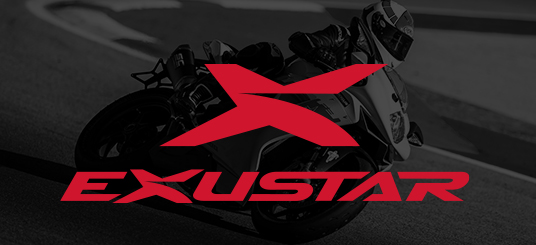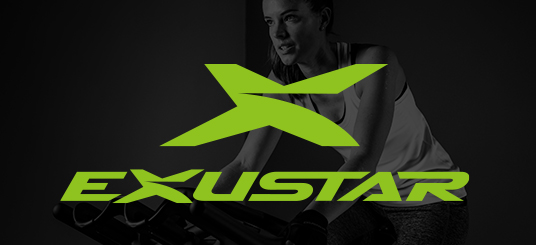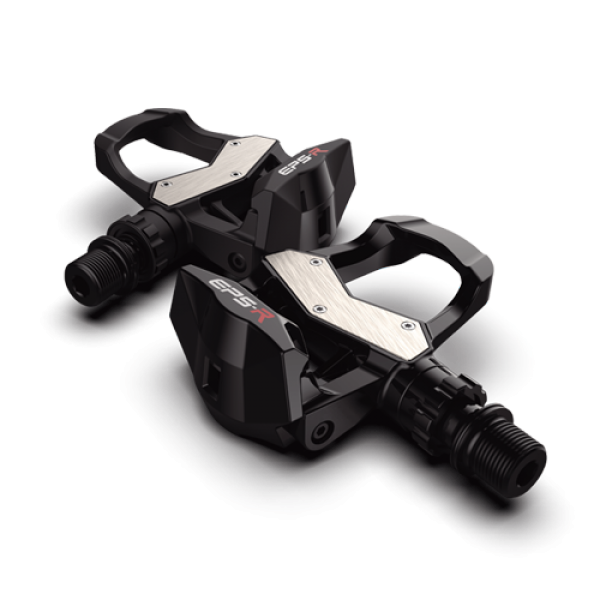⚠️ WARNING
Always carefully read product instructions before use.
Consult a bicycle dealer if you have any questions.
FAQ
PEDALS IN GENERAL
Do pedals with titanium axles have any limitations?
Titanium is a great way to lighten your ride, but frankly speaking, titanium has some limitations as a material for pedal axles. If a steel and a Ti axle are proportionally the same, the steel axle will be harder and stiffer than the Ti. It is for this reason that Exustar recommends that riders over 85 kg (187 lb) do NOT use titanium axle-equipped pedals. Doing so will void your warranty.
How do you designate pedals Ultralight or Lightweight?
This is our own company standard. Ultralight pedals are 240 g/pr or under, while Lightweight pedals are 241 to 300 g/pr. Weights are for pairs in grams.
CLIP-IN PEDALS
What are clip-in (clipless) pedals?
Bike racers long ago began binding their shoes to their pedals with toe clips and straps. They knew that a secure connection minimizes lateral movement, channelling power more efficiently to the pedal. These days clip-in pedals and compatible shoes are considered the best means of achieving the same effect. The shoe sole has a cleat; the pedal a binding: the cleat locks into the binding (a concept borrowed from skiers). If you want to maximize power transmission, you should consider clip-in pedals.
What kind of clip-in pedals are suitable for me?
There are different kinds of clip-in pedals. Some are highly specialized (Road, Indoor, MTB) others are more utilitarian. If you are a novice, and don't have a specialized use in mind, consider Exustar Multi-function pedals as a versatile, practical option for different kinds of footwear in different kinds of riding situations.
⚠️WARNINGS
For new users of clip-in pedals
Clip-in pedals are not for everyone, and in certain situations can be less convenient, or even less safe than regular platform pedals. Talk to an Exustar dealer for advice on whether they are suitable for you.
If you have never used clip-in pedals before, take time to learn how to use them safely. Read the provided instructions carefully. Make sure the tension adjuster is set to the lowest setting. Sit on, or stand over your bike with one foot firmly on the ground. With the other foot, practice engaging and disengaging with your cleat-attached shoe–the pedal should be at the 6 o'clock position (closest to the ground). When you get used to this, progress to riding slowly in a safe, traffic-free area until engagement and disengagement become natural actions that you can manage easily without looking at your feet.
- Make sure the pedal binding tension adjuster is set to the lowest setting.
- Always engage or disengage the cleat when the pedal is at the 6 o'clock position (closest to the ground).
- Before riding with clip-in pedals, practice in a safe, stationary position before progressing to a traffic-free area.
Help, my shoes won't release from the pedals?
In this situation, continue riding slowly until you come to a large solid object (a wall, a tree, a signpost etc.) that you can grab safely with your hand when you stop–holding this object will prevent you toppling over. Brake gradually, coming to a complete stop alongside the object, and hold onto it.
With the pedal at the 6 o'clock position (closest to the ground), unbuckle or unlace your shoe, remove your foot from the shoe and get off the bike. Twist shoe off the pedal by hand if possible.
If that does not work, set binding tension on pedal to lowest setting (–) and try again.
If you still cannot remove the shoe from the pedal …
Use a long, thin steel tool such as a long Allen key or flathead screwdriver as a lever to open the pedal binding. Place one end of the tool between the cleat and the pedal's rear binding (see fig. 1.). With one hand holding the rear of the shoe, twist or lever the shoe out of pedal binding with the tool (see fig. 2.).
If you can remove the shoe from the pedal binding, go through this checklist to establish the cause of the problem and remedy it:
- Is the cleat tightly fixed to the shoe and aligned straight (pointing ahead)? If it is not, loosen the cleat, realign, and retighten firmly.
- Is the cleat badly worn? If so, replace both cleats.
- Is the pedal binding damaged or distorted? If so, replace both pedals.
- Is the shoe sole damaged? If so, replace both shoes.
If the issues above do not apply or have been resolved, try using the pedals again while stationary, with the pedal binding set on the lowest tension.
TIP
Remember it is easier to engage or disengage the cleat when the pedal is at the 6 o'clock position (closest to the ground).
INDOOR PEDALS
⚠️ WARNING
Only use purpose-built Exustar pedals for indoor cycling. Do not use conventional Exustar pedals for indoor cycling.
Indoor pedals are incompatible with conventional bicycles or outdoor use.
Which pedals should I use for indoor cycling?
Indoor cycling can be very intense exercise. This can be very hard on equipment. This is particularly true of the fitness center environment where indoor classes are held. In any given week, perhaps dozens of people, all of different body weight, riding ability, and levels of equipment knowledge, are using the same bike. For this reason, instructors, and, preferably users, need to check the condition of the bike and its parts before each session.
Exustar indoor pedals are stronger and more durable than standard pedals, but users still need to be vigilant for signs of wear or damage, and pedals need to be repaired or replaced as appropriate.
Can I use any Exustar pedals for indoor cycling?
No. Only use Exustar pedals engineered specifically for indoor cycling. Use of any other Exustar pedals for indoor cycling will void your warranty.
What does the warranty for indoor pedals cover?
Exustar indoor pedals are warranted for use by an individual rider only. Use by multiple riders will void your warranty.
Help, my shoes won't release from the pedals? (Indoor cycling only)
With the pedal at the 6 o'clock position (closest to the ground), unbuckle or unlace your shoe, remove your foot from the shoe and get off the bike. Twist shoe off the pedal by hand if possible.
If that does not work, set binding tension on pedal to lowest setting (–) and try again.
If you still cannot remove the shoe from the pedal …
Use a long, thin steel tool such as a long Allen key or flathead screwdriver as a lever to open the pedal binding. Place one end of the tool between the cleat and the pedal's rear binding (see fig. 1.). With one hand holding the rear of the shoe, twist or lever the shoe out of pedal binding with the tool (see fig. 2.).


If you can remove the shoe from the pedal binding, go through this checklist to establish the cause of the problem and remedy it:
- Is the cleat tightly fixed to the shoe and aligned straight (pointing ahead)? If it is not, loosen the cleat, realign, and retighten firmly.
- Is the cleat badly worn? If so, replace both cleats.
- Is the pedal binding damaged or distorted? If so, replace both pedals.
- Is the shoe sole damaged? If so, replace both shoes.
If the issues above do not apply or have been resolved, try using the pedals again with the pedal binding set on the lowest tension.
TIP
Remember it is easier to engage or disengage the cleat when the pedal is at the 6 o'clock position (closest to the ground).
Important Notice to Fitness Center Operators
Exustar Indoor pedals are warranted for use by an individual rider only. Use by multiple riders will void warranty.
If used in indoor cycling classes, pedals should be inspected by instructors prior to each session. For the safety of riders, pedals that have squeaky, rough or loose axle/bearings, other loose parts, or are in any way damaged badly worn should be immediately repaired or replaced.
If not used in organized classes, pedals should be likewise inspected at least once a day.



